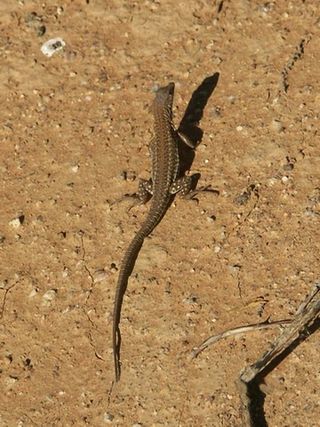
Amphisbaenia is a group of typically legless lizards, comprising over 200 extant species. Amphisbaenians are characterized by their long bodies, the reduction or loss of the limbs, and rudimentary eyes. As many species have a pink body and scales arranged in rings, they have a superficial resemblance to earthworms. While the genus Bipes retains forelimbs, all other genera are limbless. Phylogenetic studies suggest that they are nested within Lacertoidea, closely related to the lizard family Lacertidae. Amphisbaenians are widely distributed, occurring in North America, Europe, Africa, South America, Western Asia and the Caribbean. Most species are less than 6 inches (15 cm) long.

Latastia is a genus of lizards of the family Lacertidae. Species of this genus are distributed in Africa but one subspecies lives in Yemen. Collectively, they are known as long-tailed lizards.

Meroles is a genus of lizards, commonly known as desert lizards, in the family Lacertidae. The genus contains eight species, inhabiting southwestern Africa, especially the Namib Desert.

Podarcis is a genus of lizards in the family Lacertidae. Its members look very similar to lizards of the genus Lacerta, to which they were considered to belong until the 1970s. While similar externally and ecologically, Podarcis form a distinct group differing from Lacerta by the construction of the skull and the hemipenis, and by the processes of the caudal vertebrae. They are commonly known as wall lizards. They are native to Europe and northern Africa, and most species are restricted to the Mediterranean region. Wall lizards diversified and hybridized during the Messinian salinity crisis. The Italian wall lizard and the common wall lizard have been introduced to North America, where they have become intermediate hosts for some Acuariidae larvae.

Gymnophthalmus is genus of lizards in the family Gymnophthalmidae. The genus is native to Mexico, Central America, and the northern part of South America. Eight species are recognized as being valid.

The Amphisbaenidae are a family of amphisbaenians, a group of limbless vertebrates.
Robert Friedrich Wilhelm Mertens was a German herpetologist. Several taxa of reptiles are named after him. He postulated Mertensian mimicry.

Uromastyx geyri is a species of lizard belonging to the family Agamidae. The species is native to North Africa.
Lorenz Müller was a German herpetologist.

Blanus, also known as worm lizards, are a genus of amphisbaenians found in the Mediterranean region of Europe and North Africa. Like other amphisbaenians, Blanus species are specialized for a subterranean existence, with long, slender bodies, reduced limbs, and rudimentary eyes. Their skulls are powerfully constructed, allowing them to push through soil to create a burrow. Their jaws are well-developed, with large, recurved teeth and a pair of canine-like teeth in the upper jaw.

Diploglossidae is a family of anguimorph lizards native to the Americas, with most genera being endemic to Hispaniola. Most members of this family are known as galliwasps. They were formerly considered a subfamily of Anguidae, but genetic evidence has shown them to be less closely related to other members of Anguidae than Anniellidae is.

Amphisbaena is a genus in the family Amphisbaenidae, commonly known as worm lizards. Over 100 species are placed in this diverse genus.

Amphisbaena mertensii, also known as the Mertens' worm lizard or Mertens's worm lizard, is a species of worm lizard in the family Amphisbaenidae. The species is endemic to South America.
Ancylocranium is a genus of amphisbaenians in the family Amphisbaenidae, commonly known as sharp-snouted worm lizards. Three species are placed in this genus, which is endemic to eastern Africa and the Horn of Africa.

Leposternon is a genus of amphisbaenians in the family Amphisbaenidae. Species in the genus are commonly known as worm lizards. 11 species are placed in this genus.

Dopasia is a genus of lizards in the family Anguidae. The genus contains seven species, which are native to Asia. They are most closely related to the North American Ophisaurus, and are sometimes considered part of that genus.
Amphisbaena roberti is a species of worm lizard in the family Amphisbaenidae. The species is endemic to South America.
The Inirida worm lizard is a species of amphisbaenian in the family Amphisbaenidae. The species is native to Colombia and Venezuela.
Mesobaena rhachicephala is a worm lizard species in the family Amphisbaenidae. It is endemic to Pará, Brazil.
Monopeltis sphenorhynchus, also known commonly as Maurice's slender worm lizard, Maurice's spade-snouted worm lizard, and the slender spade-snouted worm lizard, is a species of amphisbaenian in the family Amphisbaenidae. The species is native to southern Africa. There are two recognized subspecies.











